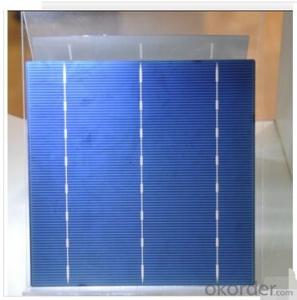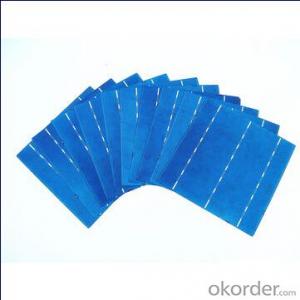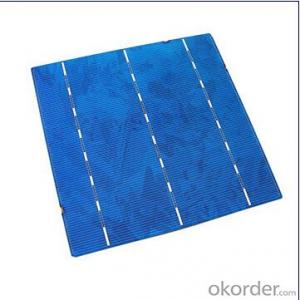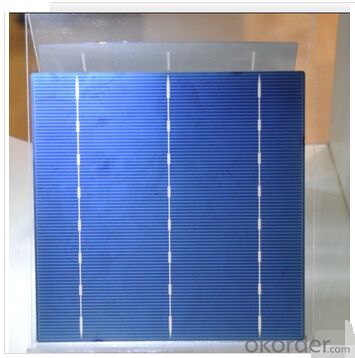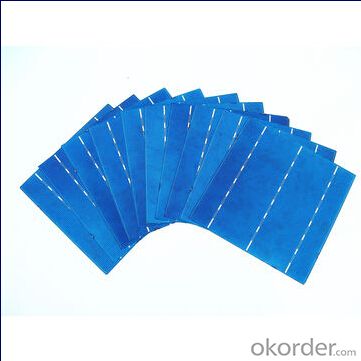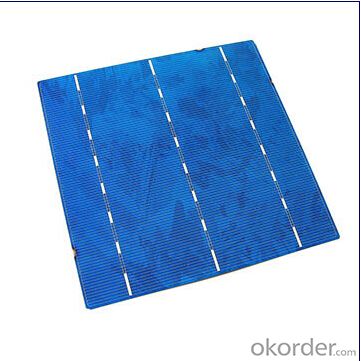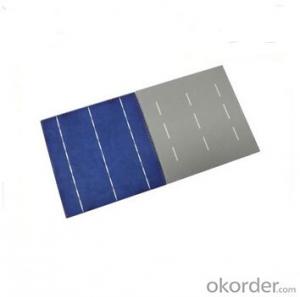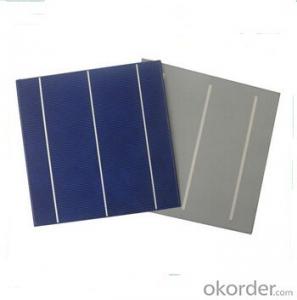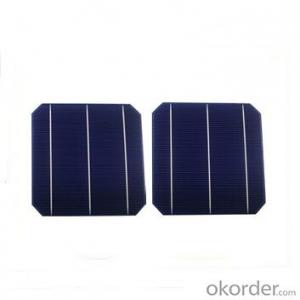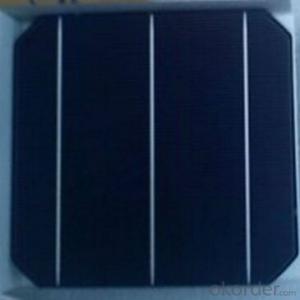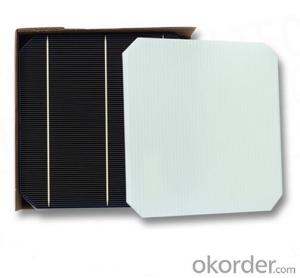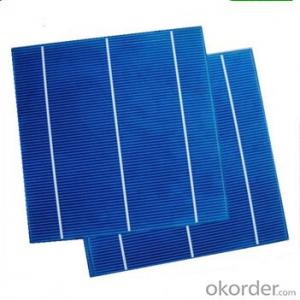Solar Cells Australia - Polycrystalline Solar Cells Series- 17.8%
- Loading Port:
- Shanghai
- Payment Terms:
- TT OR LC
- Min Order Qty:
- 1000 pc
- Supply Capability:
- 100000 pc/month
OKorder Service Pledge
OKorder Financial Service
You Might Also Like
Solar Cells:
Solar cells is made by solar wafer, it has three categories of solar cell right now, monocrystalline polycrystalline and thin film,These cells are entirely based around the concept PN junction, which is the critical part of solar module, it is the part that can convert the light energy into electricity, the thickness is from 180um to 200um, with even busbars to conduct electricity, textured cell can decrease diffuse reflection; they are often electrically connected and encapsulated as a module. Photovoltaic modules often have a sheet of glass on the front (sun up) side, allowing light to pass while protecting semiconductor wafers from abrasion and impact due to wind-driven debris, rain, hail, etc. Solar cells are also usually connected in series in modules, creating an additive voltage. Connecting cells in parallel will yield a higher current;With high quality and stable quality. Our Cells can greatly improve the performance of Solar Modules.
Features:
1. High conversion efficiencies resulting in superior power output performance.
2. Outstanding power output even in low light or high temperature conditions
3. Optimized design for ease of soldering and lamination
4. Long-term stability, reliability and performance
5. Low breakage rate
6. Color uniformity
Solar Cells Advantage:
1. Tire-1 Solar Cells’ Manufacturer Quality Guarantee. With a complete and sophisticated quality government system, our Quality Management have arrived world’s leading place. Customer can receive Tire-1 Cells Maker’s Quality Standard Products.
2. Trusted Warranty. We can supply trusted after-sales service to our customer. If our cells are found not in conformity to the specification of manufacturer, or should the inspected quantity found in shortage, or should the packing found damaged, the buyer has the right to claim to the seller. The claim, if any, should be presented to seller within 30 days after cargo's arrival date to the port, together with related inspection report and photos issued and provided by a reputable independent surveyor such as SGS.
3. World’s Leading Manufacturer Equipment. We imported the newest and leading production equipment from abroad. Advanced equipment can guarantee the stable quality of cells. Auto production line can also save labor cost which will further cut our production cost.
4. Bulk supply: With the production capacity of 500MW, we can produce large quantity every month. This can satisfy most customer requirement.
Specifications:
Efficiency | Power | Max Power Current | Min Power Current | Max Power Voltage | Short Circuit Current | Open Circuit Voltage |
Eff(%) | Ppm(W) | Ipm(A) | Ipm(A) | Vpm(V) | Isc(A) | Voc(V) |
18.20-18.39 | 4.43 | 8.53 | 8.36 | 0.532 | 8.82 | 0.633 |
18.00-18.19 | 4.38 | 8.40 | 8.26 | 0.529 | 8.78 | 0.630 |
17.80-17.99 | 4.33 | 8.33 | 8.20 | 0.527 | 8.74 | 0.629 |
17.60-17.79 | 4.28 | 8.29 | 8.08 | 0.524 | 8.70 | 0.628 |
17.40-17.59 | 4.23 | 8.26 | 8.03 | 0.522 | 8.66 | 0.625 |
17.20-17.39 | 4.19 | 8.22 | 7.99 | 0.520 | 8.61 | 0.623 |
Product | Polycrystalline silicon solar cell | |||||
Dimension | 156mm×156mm ±0.5mm | |||||
Thickness(Si) | 200µm±15µm | |||||
Front | Blue silicon nitride antireflection coatings 1.4mm silver busbar 3BB | |||||
Back | Full-surface aluminum back-surface field 2.6mm silver continuous or discrete soldering p | |||||
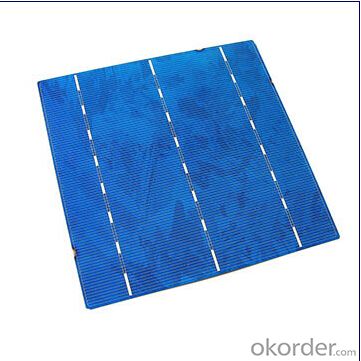
FAQ
We have organized several common questions for our clients,may help you sincerely:
①What price for each watt?
It depends on the efficiency of the solar cell, quantity, delivery date and payment terms.
②How long can we receive the product after purchase?
In the purchase of product within three working days, We will arrange the factory delivery as soon as possible. The pecific time of receiving is related to the state and position of customers.Commonly 7 to 10 working days can be served.
③Can you provide the peripheral products of the solar panels, such as the battery, controller, and inverter? If so, can you tell me how do they match each other?
Yes, we can, we have two companies for solar region, one is CNBM International, the other is CNBM engineering Co.
We can provide you not only the solar module but also the off grid solar system, we can also provide you service with on grid plant.
④What is your warranty of solar cell?
Our product can promise lower than 0.3% open box crack, we support claim after opening the box if it has crackm color difference or sth, the buyer should give pictures immediately, we can not accept the claim after the solar cell has assembled to solar panel.
• Timeliness of delivery
• ⑤How do you pack your products?
We have rich experience on how to pack the solar cell to make sure the safety on shipment, we could use wooden box or pallet as buyer's preference.
- Q: Can solar cells be used in satellites?
- Yes, solar cells can be and are commonly used in satellites as they provide a reliable and efficient source of power by converting sunlight into electricity.
- Q: What is the impact of wind on solar cell efficiency?
- The impact of wind on solar cell efficiency is generally minimal. While wind can cause slight vibrations or movements in solar panels, it does not significantly affect the overall efficiency of the cells. The main factors that influence solar cell efficiency are the angle and orientation of the panels towards the sun, as well as the amount of sunlight received.
- Q: What is the difference between a monocrystalline and polycrystalline solar cell?
- The main difference between a monocrystalline and polycrystalline solar cell lies in the structure of the silicon material used. Monocrystalline solar cells are made from a single crystal structure, resulting in a uniform and consistent appearance with a high level of efficiency. On the other hand, polycrystalline solar cells are made from multiple crystal structures, giving them a fragmented and non-uniform appearance with a slightly lower efficiency. Overall, monocrystalline cells tend to be more expensive but offer higher efficiency, while polycrystalline cells are more affordable but slightly less efficient.
- Q: What is a thin-film solar cell?
- A thin-film solar cell is a type of solar cell that is made using very thin layers of semiconductor materials. These layers are typically only a few micrometers thick, which makes the solar cell much lighter and more flexible compared to traditional solar cells. Thin-film solar cells are less efficient at converting sunlight into electricity but are more cost-effective and can be used in a wider range of applications.
- Q: Can the 156x156mm high efficiency single crystal cells assembly function better compared to the traditional one?
- Our company is planning to upgrade our supply system into the 156x156mm high efficiency single crystal celsl assembly, but we are still not sure if it is really that great.
- Q: What is the environmental impact of solar cells?
- The environmental impact of solar cells is generally positive. They produce clean and renewable energy, reducing greenhouse gas emissions and dependence on fossil fuels. However, their production does require some raw materials and energy, which can have environmental consequences. Additionally, the disposal of older solar panels may pose challenges in terms of electronic waste management. Overall, though, the benefits of solar cells outweigh their environmental drawbacks.
- Q: How long do solar cells last?
- Solar cells typically have a lifespan of around 25 to 30 years, but with proper maintenance and care, they can continue producing electricity for even longer.
- Q: Can solar cells be used in remote sensing applications?
- Yes, solar cells can be used in remote sensing applications. Solar cells can generate electricity from sunlight, which can be used to power sensors, data loggers, and communication devices in remote sensing systems. This allows for continuous and self-sustained operation of these systems in remote and inaccessible areas where traditional power sources are unavailable.
- Q: Can solar cells be used in theme parks?
- Yes, solar cells can be used in theme parks. Solar cells can be installed on rooftops, parking lots, or open spaces within theme parks to generate clean and renewable energy. This energy can be used to power rides, lighting, and other facilities, reducing the park's dependence on traditional energy sources and lowering its carbon footprint. Additionally, solar cells can also serve as educational tools, allowing visitors to learn about renewable energy and sustainability.
- Q: Can solar cells be used in off-grid cabins or cottages?
- Yes, solar cells can definitely be used in off-grid cabins or cottages. Solar panels can generate electricity by converting sunlight into usable energy, which can then be stored in batteries for later use. This makes them an excellent choice for powering remote locations like off-grid cabins or cottages where access to the electrical grid may be limited or non-existent.
Send your message to us
Solar Cells Australia - Polycrystalline Solar Cells Series- 17.8%
- Loading Port:
- Shanghai
- Payment Terms:
- TT OR LC
- Min Order Qty:
- 1000 pc
- Supply Capability:
- 100000 pc/month
OKorder Service Pledge
OKorder Financial Service
Similar products
Hot products
Hot Searches
Related keywords
